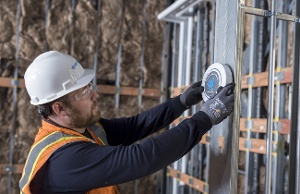Smarten up your project with Polygon
GET FAMILAR
GET SMARTER
At Polygon, we specialize in advanced climate solutions tailored for mass timber projects—offering real-time monitoring, precise humidity control, and expert guidance to protect materials at every stage. Discover how Polygon can help you safeguard mass timber and other construction materials for your next project.
Indoor air quality is important on construction jobsites for several reasons. One, controlling dust and fumes supports productivity and the health of workers. Two, good air quality can protect duct work and reduce health risks to future occupants. Third, maintaining good conditions can help protect sensitive components and equipment from moisture and dust during and after installation.
Sources of poor IAQ include dust or particulate matter (PM) from combustion and materials like silica, fiberglass, asbestos, wood, and paving in and around the site. Harsh fumes from curing, painting, and finishes can compromise IAQ. Even moisture or unaddressed water leaks pose an issue because they can lead to mold growth and increased humidity, which can worsen indoor air quality (IAQ) by triggering respiratory problems, allergens, and the spread of harmful microorganisms.

Sources of poor IAQ include dust or particulate matter (PM) from combustion and materials like silica, fiberglass, asbestos, wood, and paving in and around the site. Harsh fumes from curing, painting, and finishes can compromise IAQ. Even moisture or unaddressed water leaks pose an issue because they can lead to mold growth and increased humidity, which can worsen indoor air quality (IAQ) by triggering respiratory problems, allergens, and the spread of harmful microorganisms.


Job trailers and surrounding buildings are often overlooked. Adding sensors to monitor potential problems can help reduce future risks or simply let works know when to open a door or window.
Mission critical and data centers require additional IAQ management to ensure safe installation of sensitive components. Verifying and documenting environmental conditions is particularly critical at commissioning. Access to historical trends and evidence of current conditions helps teams prove proper measures were taken and the building meets specifications.
Some insurance carriers offer lower deductibles or premiums when monitoring is deployed because it can reduce risk. Ask your insurance broker about incentives for monitoring.
Next Article